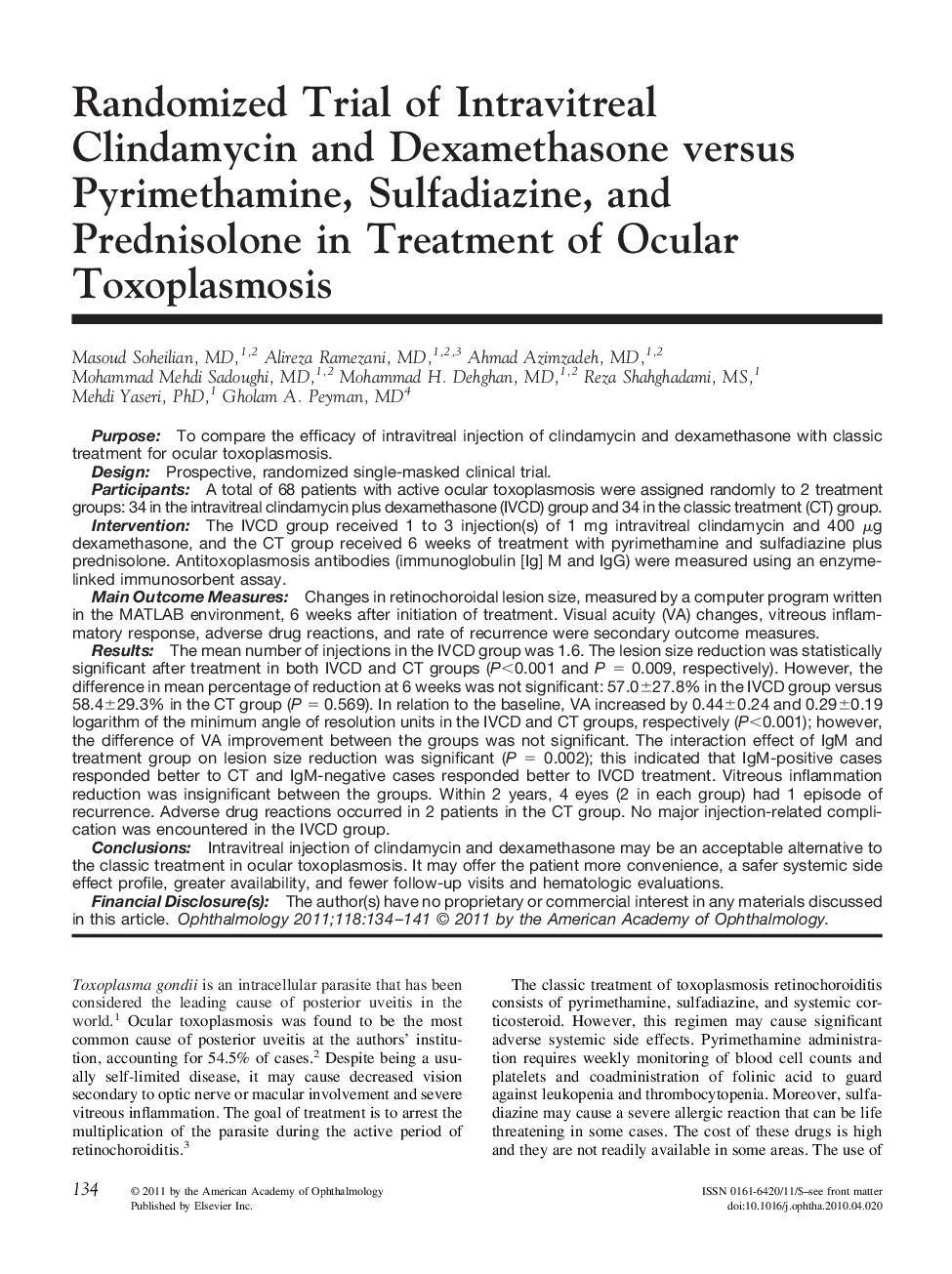| کد مقاله | کد نشریه | سال انتشار | مقاله انگلیسی | نسخه تمام متن |
|---|---|---|---|---|
| 4027185 | 1262450 | 2011 | 8 صفحه PDF | دانلود رایگان |

PurposeTo compare the efficacy of intravitreal injection of clindamycin and dexamethasone with classic treatment for ocular toxoplasmosis.DesignProspective, randomized single-masked clinical trial.ParticipantsA total of 68 patients with active ocular toxoplasmosis were assigned randomly to 2 treatment groups: 34 in the intravitreal clindamycin plus dexamethasone (IVCD) group and 34 in the classic treatment (CT) group.InterventionThe IVCD group received 1 to 3 injection(s) of 1 mg intravitreal clindamycin and 400 μg dexamethasone, and the CT group received 6 weeks of treatment with pyrimethamine and sulfadiazine plus prednisolone. Antitoxoplasmosis antibodies (immunoglobulin [Ig] M and IgG) were measured using an enzyme-linked immunosorbent assay.Main Outcome MeasuresChanges in retinochoroidal lesion size, measured by a computer program written in the MATLAB environment, 6 weeks after initiation of treatment. Visual acuity (VA) changes, vitreous inflammatory response, adverse drug reactions, and rate of recurrence were secondary outcome measures.ResultsThe mean number of injections in the IVCD group was 1.6. The lesion size reduction was statistically significant after treatment in both IVCD and CT groups (P<0.001 and P = 0.009, respectively). However, the difference in mean percentage of reduction at 6 weeks was not significant: 57.0±27.8% in the IVCD group versus 58.4±29.3% in the CT group (P = 0.569). In relation to the baseline, VA increased by 0.44±0.24 and 0.29±0.19 logarithm of the minimum angle of resolution units in the IVCD and CT groups, respectively (P<0.001); however, the difference of VA improvement between the groups was not significant. The interaction effect of IgM and treatment group on lesion size reduction was significant (P = 0.002); this indicated that IgM-positive cases responded better to CT and IgM-negative cases responded better to IVCD treatment. Vitreous inflammation reduction was insignificant between the groups. Within 2 years, 4 eyes (2 in each group) had 1 episode of recurrence. Adverse drug reactions occurred in 2 patients in the CT group. No major injection-related complication was encountered in the IVCD group.ConclusionsIntravitreal injection of clindamycin and dexamethasone may be an acceptable alternative to the classic treatment in ocular toxoplasmosis. It may offer the patient more convenience, a safer systemic side effect profile, greater availability, and fewer follow-up visits and hematologic evaluations.Financial Disclosure(s)The author(s) have no proprietary or commercial interest in any materials discussed in this article.
Journal: Ophthalmology - Volume 118, Issue 1, January 2011, Pages 134–141